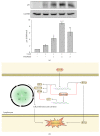Hinokitiol Negatively Regulates Immune Responses through Cell Cycle Arrest in Concanavalin A-Activated Lymphocytes
- PMID: 26379747
- PMCID: PMC4563105
- DOI: 10.1155/2015/595824
Hinokitiol Negatively Regulates Immune Responses through Cell Cycle Arrest in Concanavalin A-Activated Lymphocytes
Abstract
Autoimmune diseases are a group of chronic inflammatory diseases that arise from inappropriate inflammatory responses. Hinokitiol, isolated from the wood of Chamaecyparis taiwanensis, engages in multiple biological activities. Although hinokitiol has been reported to inhibit inflammation, its immunological regulation in lymphocytes remains incomplete. Thus, we determined the effects of hinokitiol on concanavalin A- (ConA-) stimulated T lymphocytes from the spleens of mice. In the present study, the MTT assay revealed that hinokitiol (1-5 μM) alone did not affect cell viability of lymphocytes, but at the concentration of 5 μM it could reduce ConA-stimulated T lymphocyte proliferation. Moreover, propidium iodide (PI) staining revealed that hinokitiol arrested cell cycle of T lymphocytes at the G0/G1 phase. Hinokitiol also reduced interferon gamma (IFN-γ) secretion from ConA-activated T lymphocytes, as detected by an ELISA assay. In addition, hinokitiol also downregulated cyclin D3, E2F1, and Cdk4 expression and upregulated p21 expression. These results revealed that hinokitiol may regulate immune responses. In conclusion, we for the first time demonstrated that hinokitiol upregulates p21 expression and attenuates IFN-γ secretion in ConA-stimulated T lymphocytes, thereby arresting cell cycle at the G0/G1 phase. In addition, our findings also indicated that hinokitiol may provide benefits to treating patients with autoimmune diseases.
Figures




Similar articles
-
Antiproliferative Activity of Hinokitiol, a Tropolone Derivative, Is Mediated via the Inductions of p-JNK and p-PLCγ1 Signaling in PDGF-BB-Stimulated Vascular Smooth Muscle Cells.Molecules. 2015 May 7;20(5):8198-212. doi: 10.3390/molecules20058198. Molecules. 2015. PMID: 25961161 Free PMC article.
-
[Human amniotic mesenchymal stem cells inhibit allogeneic lymphocyte proliferation and reduce the secretion of interferon γ].Xi Bao Yu Fen Zi Mian Yi Xue Za Zhi. 2015 Mar;31(3):333-7. Xi Bao Yu Fen Zi Mian Yi Xue Za Zhi. 2015. PMID: 25744838 Chinese.
-
p27-Associated G1 arrest induced by hinokitiol in human malignant melanoma cells is mediated via down-regulation of pRb, Skp2 ubiquitin ligase, and impairment of Cdk2 function.Cancer Lett. 2009 Dec 28;286(2):240-9. doi: 10.1016/j.canlet.2009.05.038. Epub 2009 Jul 23. Cancer Lett. 2009. PMID: 19631451
-
[Effect of a soluble Jagged 1/Fc chimera protein on the activation, proliferation and cell cycle of lymphocytes in mice].Xi Bao Yu Fen Zi Mian Yi Xue Za Zhi. 2008 Jan;24(1):6-9. Xi Bao Yu Fen Zi Mian Yi Xue Za Zhi. 2008. PMID: 18177607 Chinese.
-
Sceptridium ternatum attenuates allergic contact dermatitis-like skin lesions by inhibiting T helper 2-type immune responses and inflammatory responses in a mouse model.J Dermatol Sci. 2015 Sep;79(3):288-97. doi: 10.1016/j.jdermsci.2015.06.012. Epub 2015 Jun 26. J Dermatol Sci. 2015. PMID: 26150208
Cited by
-
New therapeutic strategy of hinokitiol in haemorrhagic shock-induced liver injury.J Cell Mol Med. 2019 Mar;23(3):1723-1734. doi: 10.1111/jcmm.14070. Epub 2018 Dec 8. J Cell Mol Med. 2019. PMID: 30548082 Free PMC article.
-
Hinokitiol Inhibits Migration of A549 Lung Cancer Cells via Suppression of MMPs and Induction of Antioxidant Enzymes and Apoptosis.Int J Mol Sci. 2018 Mar 22;19(4):939. doi: 10.3390/ijms19040939. Int J Mol Sci. 2018. PMID: 29565268 Free PMC article.
References
LinkOut - more resources
Full Text Sources
Other Literature Sources
Research Materials
Miscellaneous

